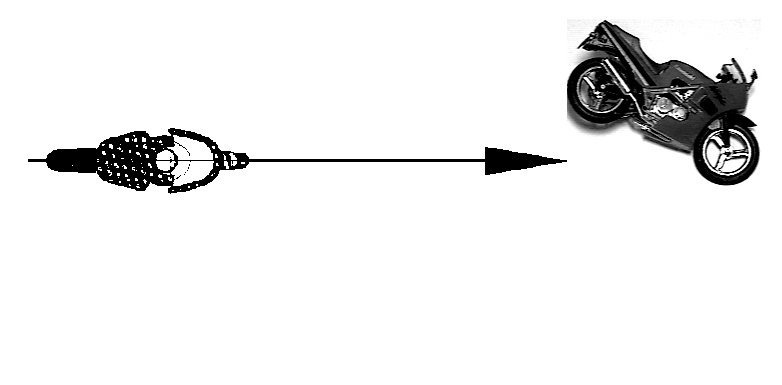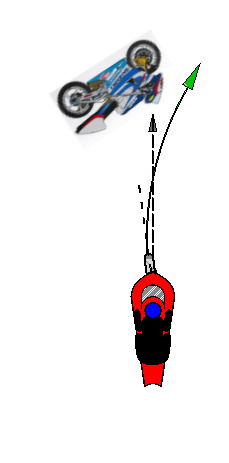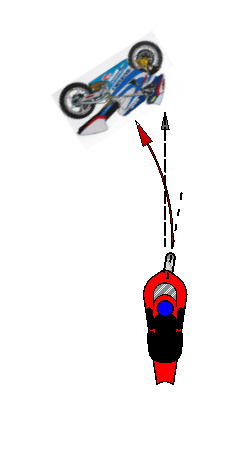Problem with PANIC

The Problem with Panic
A topic we need to discuss and understand is the concept of panic and how it causes the rider serious problems trying to avoid a hazard.
Panic is usually caused when, unexpectedly, and suddenly something dangerous happens. There are different levels of panic, from a minor gasp with heart in the throat to the, all out “OMG… I’m gonna die”. Different people will have different levels of panic. There are people who will jump out of their skins just from a loud noise. Then there are those who don’t panic at all.
“Push right to go right” as described above, or even the old school “counter-steer” term sounds easy. But, in a panic situation, many riders will not be able to start the lean and turn in time, if at all, to avoid a hazard. If used properly, you can actually think your way out of a panic situation with the PUSH/PULL technique.
To understand what happens when you panic, we need to look at some human physiology. As human beings, we were born with a “primordial instinct for survival”. This helped us survive as the cave men did I.E., the fight or flight, run or hide behavior. Riding a motorcycle or even a bicycle is not a primordial instinct. If it were, then the day we learned to walk as a child, we could have jumped on a two-wheeler and ridden away. Most of us were not able to do that. Everyone needed to have Mom, Dad, big brother, training wheels, or something to hold us up on the two-wheeler until we “learn to balance” or “catch the balance”.
This “learned balance” is not a primordial instinct. It is instead, a learned behavior, a conditioned reflex, muscle memory, or a secondary instinct--whatever you want to call it. The more we do something, the more “Second Nature” it becomes. As long as everything is going as planned without panic, we can ride, turn, balance, and maybe even do some stunts. This can be called riding by the “seat of the pants”, or just riding on instinct.
If you ride by the “seat of the pants, you will be predisposed to panic when something sudden happens. Once you get into a into a panic mode, you’re in trouble. There is an old saying, “Panic Kills”. That saying applies to many other athletic disciplines but, especially to motorcycle riding.
The Problem with Panic
The biggest problem is that panic will cause you to go from Learned behaviors back down into your basic Primordial Instinct. It is this primordial instinct which is incorrect for balancing and turning a motorcycle.
(Figure 1) We will use an example of a blue motorcycle which has suddenly crashed directly in front of our rider. In this situation, a rider can easily panic and unknowingly revert to the “Primordial Instinct of Survival”. Unfortunately, this instinct is often the opposite of what the rider needs to do to avoid involvement in the crash. The rider must react and make a corrective action very quickly. Any hesitation, no matter how slight, can be disastrous. Without proper understanding of the dynamics of steering, the rider cannot achieve rapid and accurate control in a panic.
 FIGURE 1
FIGURE 1
(Figure 2) To successfully clear the fallen bike the rider must accomplish the two steps to turn,
1. Start the lean to the right which is accomplished by deflecting the front wheel to the left for a split second. “Steer left to lean right”, "Push right to go right", “Counter Steer”, or what ever you call it. The important point to notice here is, to lean to the right, you must point the front wheel slightly to the left, which is directly at the hazard the rider is trying to avoid.
2. Start the turn to the right. Once the bike is leaning right then, either a slight pull on the right handlebar or input from the steering geometry will accomplish this. The front wheel will then be pointed somewhat to the right and the bike will start to turn right. Luckily the start of the turn is almost automatic once the lean has been introduced. But, you have to get the lean started before you can start turn.
 FIGURE 2
FIGURE 2
In theory, to go right simply push right. That’s easily to say and to accomplish in a non-panic situation. The rider can do it even while riding by the seat of the pants.
Let’s explain what happens in a panic.
(Figure 3) In this example we can see what happens to a rider that is in panic mode. If you think “Counter Steer”, what does that mean, steer away from the hazard? Or steer toward the hazard? If you have to think about it, you just took too long.
 FIGURE 3
FIGURE 3
When the primordial instinct takes over, from panic, it will cause the rider to, subconsciously, try to steer AWAY from the hazard by pointing the front wheel to the right. Unfortunately, pointing the wheel to the right will cause the bike to lean to the left and turn into the hazard. The rider can sense the bike is not turning the right way, so this adds to the panic and he stops all steering inputs. He ends up getting the feeling, "I can't turn.....I can't turn!" and freezes on the handlebars while staring directly at the hazard and plough straight into it. This freezing is often referred to as “Target Fixation”.
The easiest way to avoid this target fixation is to never look at the other rider or bike. As I tell my students, “If you can identify the rider in-front of you or the type of bike he is on then, you have looked at the other bike and rider too dam long!” You should be aware of the other rider and aware of what he is doing but, never put your focus on him. If you are looking at him at the moment that he crashes then, you have, as fishermen say, “set the hook” for target fixation.
The only thing you should be looking at or for is “where you want your front wheel to go in the next several seconds. You are looking at “Clear and Unobstructed pavement”. Anything other than clear pavement is a hazard! Don’t adopt the mind set of looking at a hazard and saying, “I must avoid it” but, instead your mind set should be, look for clear pavement and thinking to yourself “that’s where I want to go”.
A hazard can be more than just a crashed bike in front of you. A hazard is anything on or near the track, other than clear, unobstructed pavement. Hazards can encompass debris, pavement patches, bumps, liquid, bike parts, fellow rider, wildlife, etc. on the track. Even the outside edge of the track can be a hazard. If you don’t want to run off the outside edge of the exit of the turn then, don’t look at it but, make yourself look down track instead. The rider who suddenly shows up right next to you in mid turn can cause a hazard. But, you must still keep your eyes on where you want to go and not on the rider passing you.